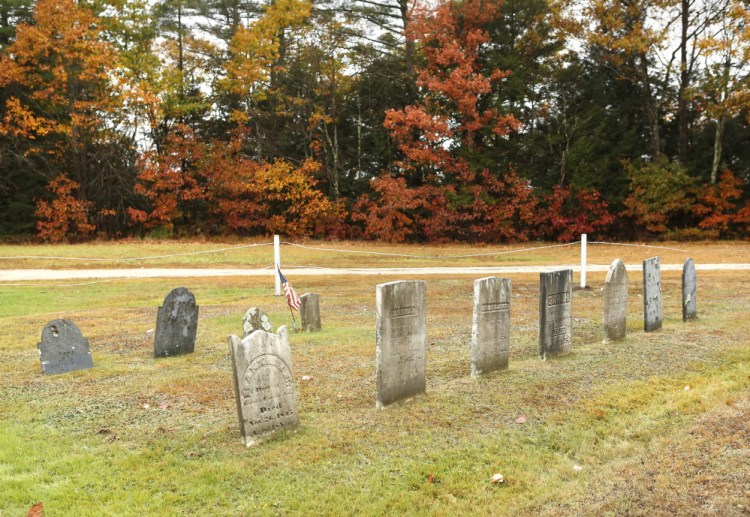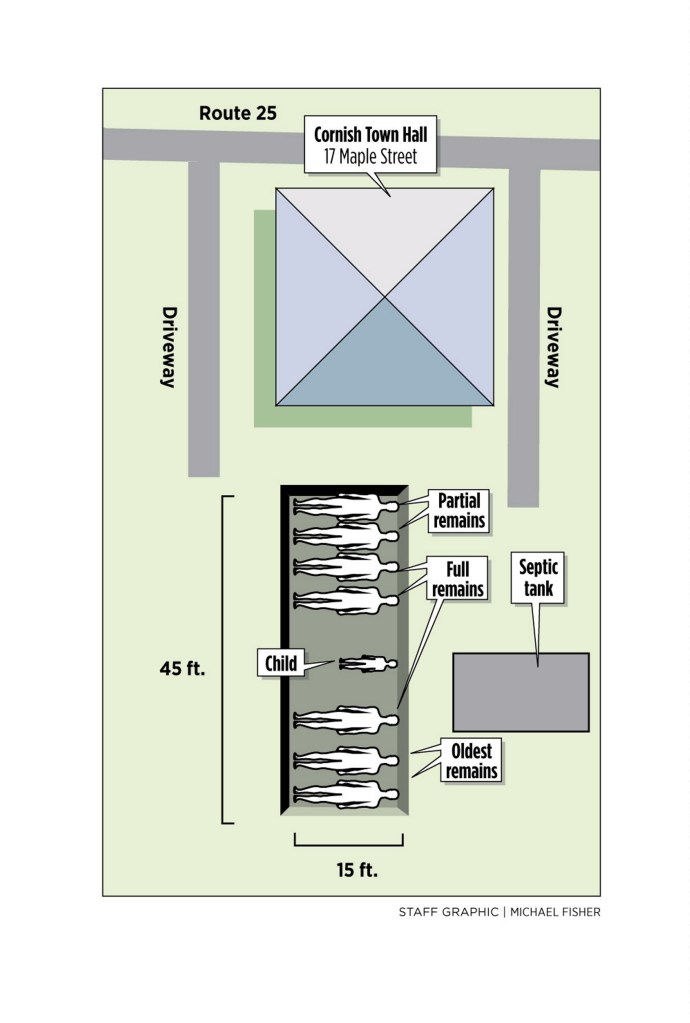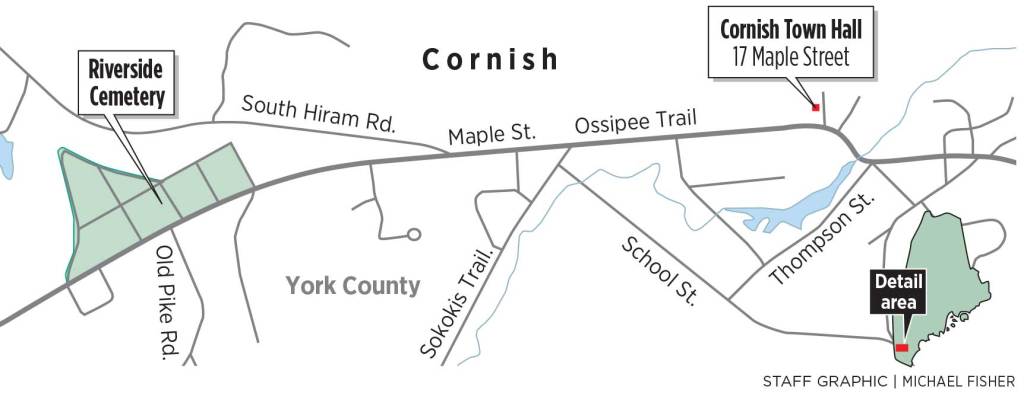CORNISH — The discovery of eight human remains under 5 feet of sandy soil behind Town Hall has Cornish officials and residents scrambling to identify who the bones belong to and figure out how they apparently were left behind from a cemetery that locals believed had been moved decades ago.
“It’s interesting and creepy all at the same time,” said Jeff Sterling, one of the construction workers who first noticed a human skull poking out of the loose soil in an excavator’s bucket during work on a drainage trench behind the 88-year-old building.
The remains were laid side-by-side in a row stretching 45 feet.
“I’m kind of embarrassed, because this has caught everyone off guard,” said Diane Perkins, secretary of the Cornish Historical Society. “It just bothers me that they were left there when they were supposed to be dug up and reburied.”
Thirteen people were believed to be buried at the old plot. A search Wednesday by a Riverside Cemetery Association official cross-checking dates and the number of remains pointed to Plot 40 in Riverside Cemetery as the likely location where the 13 were supposed to have been reburied. Twelve headstones remain there today.
“We think we’re on the right track with this,” said Emily Ward, a Cornish selectwoman.
Now, historians and cemetery stewards are scouring old documents to see if they can figure out how the bodies could have been misplaced so many years ago. The state Chief Medical Examiner’s Office will try to identify the remains.
It’s a daunting task. Only bones and fragments of wooden coffins remain, and no possessions or artifacts were found during the exhumations. Still, officials likely will be able to tell the gender and the approximate ages of the deceased.
Town officials don’t plan to keep digging to see if the other five bodies surface, noting that the site is near a septic tank that was installed in the 1960s.
If local historians are correct, the deceased were buried between 1810 and 1922, with the earliest occupant of the cemetery dating to the time of Cornish’s incorporation in 1794. It’s unclear whether the remains of that person, identified as Lewis Bennison, were among the eight that were found this week.
Because much of the town’s early historical records were lost in a fire, detailed information about the founding of the cemetery plot could not be located.
The remaining records indicate that part of the site was used as a Methodist church as early as 1831. The church stood until about 1850, when it was moved or torn down to make way for the Rose Window School, named for the structure’s only architectural flourish, a circular window that is preserved in today’s town hall.
The school remained there into the 20th century. Photographs from the early 1900s show the unnamed cemetery plot next door, enclosed by a white picket fence.
By 1922, the last body – a World War I veteran named Arthur J. Delory – was buried in the cemetery, according to records kept by the Riverside Cemetery Association.
Glenna Googins, the cemetery association’s secretary and treasurer, said the bodies were believed to have been moved as early as 1905, but that information was passed on by an elderly Cornish man, Fred Smith, whose health is declining and who could not be interviewed.
Googins said she has been searching through decades of cemetery association meeting minutes, but cannot find any mention of bodies being moved.
Riverside Cemetery Plot 40, where the 12 headstones stand, was owned by Fred C. Small, who was a secretary of the cemetery association in the 1800s, yet no one named Small is buried there.
Googins theorized that Small, a prominent citizen, was wealthy enough to buy the plot to move the graves there.
Yet Googins, leafing through handwritten records from 100 years ago, said she found nary a mention of graves having been moved.
“They had to discuss this at a meeting some time, but I can’t find a thing,” she said.
The last hope now, it seems, will be investigators at the Chief Medical Examiner’s Office in Augusta, where Marcella Sorg, a forensic anthropologist for the state and an associate research professor at the University of Maine, will examine the bones and shards of coffins. The process could take months.
Sorg could not be reached for comment Thursday, but Dana Wilson, president of the American Board of Forensic Anthropology, said scientists can learn plenty from bones, even old ones, depending on their condition.
Wilson noted that just last month, scientists in England used mitochondrial DNA analysis to positively identify remains found beneath a parking lot in Leicester in 2012 as belonging to Richard III. The King of England from 1483 to 1485, he died on the battlefield at the Battle of Bosworth.
“It’s very possible to get a positive identification, but a lot depends on how well-preserved the remains are,” said Wilson, a senior forensic anthropologist with the Tarrant County Medical Examiner’s Office in Fort Worth, Texas.
Wilson said Sorg should almost certainly be able to determine the age and sex of the remains, and might be able to say how they died or whether they suffered from any diseases or injuries.
Wilson said the discovery of unmarked cemeteries is fairly common across the country, because so many small cemeteries or family plots existed before, and even into, the early 20th century.
According to the Maine Old Cemetery Association, a group that maintains a database of such cemeteries, there are at least 33 in Cornish alone.
Staff Writer Eric Russell contributed to this report.
Send questions/comments to the editors.







Success. Please wait for the page to reload. If the page does not reload within 5 seconds, please refresh the page.
Enter your email and password to access comments.
Hi, to comment on stories you must . This profile is in addition to your subscription and website login.
Already have a commenting profile? .
Invalid username/password.
Please check your email to confirm and complete your registration.
Only subscribers are eligible to post comments. Please subscribe or login first for digital access. Here’s why.
Use the form below to reset your password. When you've submitted your account email, we will send an email with a reset code.